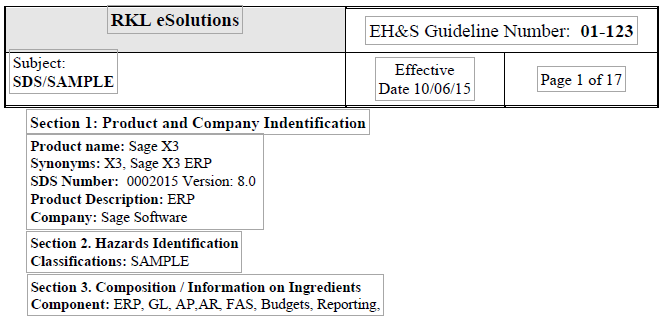New standards become effective Dec 1st!
If you’re a chemical distributor or manufacturer and you haven’t converted your Material Safety Data Sheets (MSDS) by now, you’re running out of time. In 2012, OSHA announced changes to its Hazard Communication System for manufacturers and importers of chemicals to replace MSDS with Safety Data Sheets (SDS) by December 1, 2015.
Why the change?
The change to SDS is intended to simplify communication, labeling, handling of hazardous materials, to create consistency within the industry and incorporate international standards. MSDS information was maintained in multiple formats and the information was disclosed in varied locations on documents. Below is a sample of the SDS format.
By adopting a reporting standard that includes specifically what information is documented and where it is presented, OSHA aims to increase the awareness of hazards of a chemical. The new standards will make it easier for employees and handlers to find chemical information while decreasing the document preparation costs for chemical distributors and manufacturers.
What’s different?
Safety Data Sheets (SDS) will now align with the Global Harmonization System of Classification and Labeling of Chemicals (GHS). SDS represents an international form to replace MSDS with a single format versus multiple formats along with specific order and headline information. The new form includes 16 sections of predefined information like:
- Product Identification including origin and restrictions
- Hazard Identification and label elements
- Composition/Ingredient information including properties, stabilities, and reactivity
- First-Aid response, fire-fighting measure, exposure controls, and accidental release protection
- Regulatory agency compliance for OSHA, EPA, DOT, CPSC, and others
What should you do next?
If you haven’t begun the process yet, you need to act quickly. The first step is to train your employees on the concepts and requirements of the new Safety Data Sheets. Next, obtain the necessary SDS forms from your manufacturers that you purchase hazardous chemicals from. These forms should already be in circulation, however chemical manufacturers and distributors have until Dec 1 to officially incorporate the SDS format.
Contact Us
RKL eSolutions has already helped chemical distributors and manufacturers replace MSDS with SDS. Contact us to help you implement these changes before it’s too late.
